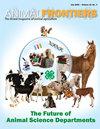Genome-edited livestock: Ethics and social acceptance
IF 3.2
2区 农林科学
Q1 AGRICULTURE, DAIRY & ANIMAL SCIENCE
引用次数: 19
Abstract
The agricultural application of genetic engineering has advanced in the field of crop breeding. In 1994, the US Food and Drug Administration (FDA) approved a genetically modified (GM) tomato variety, the world’s first GM crop for food consumption (Bruening and Lyons, 2000). In this GM tomato (the Flavr Savr), ripening was delayed by the insertion of an antisense gene that interferes with polygalacturonase production. Although the regulatory approval of GM crops largely demands strict assessments of the environmental risks and food safety, the commercial cultivation of GM crops with an exogenous gene (termed transgene) has spread to at least 28 countries, including the USA, Brazil, Argentina, India, Canada, China, and some European countries (Ishii and Araki, 2016). Conversely, there have been few regulatory approvals regarding GM livestock, with the exception of GM goats for “pharming” in which biopharmaceuticals are manufactured using transgenesis (FDA, 2009). Currently, older genetic engineering practices, such as transgenesis, are giving way to genome editing. Genome editing tools, such as zincfinger nucleases (ZFNs; Klug, 2010), transcription activator-like effector nucleases (TALENs; Joung and Sander, 2013), and the clustered regularly interspaced short palindromic repeat (CRISPR)/Cas 9 (Barrangou and Doudna, 2016), can break DNA double strands at target sites and then achieve various types of genetic modification via non-homologous end-joining (NHEJ) or homology-directed repair (HDR), thus potentially adding new value to agriculture (Figure 1). Recent reviews suggest that NHEJ is preferred in crop genome editing because the resultant plants are considered to contain no transgenes, which is one of the major concerns over GM crops from regulatory and social aspects (Hartung and Schiemann, 2014; Voytas and Gao, 2014; Araki and Ishii, 2015). Genome editing has also been applied in livestock breeding (Carlson et al., 2012; Hai et al., 2014; Crispo et al., 2015; Cui et al., 2015; Proudfoot et al., 2015; Wang et al., 2015a; Wang et al., 2015b; Wang et al., 2015c; Carlson et al., 2016; Fischer et al., 2016; Oishi et al., 2016; Petersen et al., 2016; Tanihara et al., 2016; Wang et al., 2016; Whitworth et al., 2016). Animals modified via NHEJ are unlikely to impose substantial risks on the environment because they can be managed within a farm, unlike GM crops, which are intentionally released into the environment (field cultivation). Thus, one can presume that the products derived from genome-edited livestock will soon be accepted in society if the food safety can be confirmed. However, it would be inappropriate to presume that such a favorable course of events is the only possibility. In November 2015, the FDA approved a GM salmon for food consumption (FDA, 2015). Nonetheless, citizen groups and environmentalists still loudly oppose the FDA’s decision about its safety. In addition, they questioned the environmental risk that it posed to wild salmon populations; despite that the sterile GM fish is only raised in landlocked tanks (Pollack, 2015). Such public movements may have prolonged the FDA review of the GM salmon. It took nearly a quarter of a century and cost more than $77 million (Van Eenennaam and Muir, 2011). Psychological investigations have suggested that GM animals are viewed as less acceptable than GM plants and that people’s sense of ethics has a more significant effect on the acceptance than other factors such as the perceived risks, the recognized benefits, or the trust in regulators and researchers (Zechendorf, 1994; Siegrist, 2000). Likewise, complex situations are likely to emerge in the case of livestock genome editing because animals modified via NHEJ are also genetically modified. In the present article, we consider the practical and ethical bottlenecks in obtaining the social acceptance of animal breeding by genome editing, focusing on the development of livestock strains.基因组编辑家畜:伦理和社会接受
基因工程的农业应用在作物育种领域取得了进展。1994年,美国食品和药物管理局(FDA)批准了一种转基因番茄品种,这是世界上第一个用于食品消费的转基因作物(Bruening and Lyons, 2000)。在这个转基因番茄(Flavr Savr)中,由于插入了一个干扰聚半乳糖醛酸酶产生的反义基因,成熟被推迟了。尽管转基因作物的监管批准在很大程度上要求对环境风险和食品安全进行严格评估,但带有外源基因的转基因作物(称为转基因)的商业化种植已经蔓延到至少28个国家,包括美国、巴西、阿根廷、印度、加拿大、中国和一些欧洲国家(Ishii和Araki, 2016)。相反,很少有监管机构批准转基因牲畜,除了转基因山羊用于“制药”,其中使用转基因生产生物制药(FDA, 2009)。目前,转基因等较老的基因工程实践正在让位于基因组编辑。基因组编辑工具,如锌指核酸酶(ZFNs);Klug, 2010),转录激活子样效应核酸酶(TALENs;young and Sander, 2013)和聚集的规则间隔短回文重复序列(CRISPR)/ cas9 (Barrangou and Doudna, 2016)可以在目标位点破坏DNA双链,然后通过非同源末端连接(NHEJ)或同源定向修复(HDR)实现各种类型的遗传修饰。因此可能为农业增加新的价值(图1)。最近的评论表明,NHEJ在作物基因组编辑中更受青睐,因为由此产生的植物被认为不含转基因,这是监管和社会方面对转基因作物的主要担忧之一(Hartung和Schiemann, 2014;Voytas and Gao, 2014;Araki and Ishii, 2015)。基因组编辑也已应用于家畜育种(Carlson et al., 2012;Hai et al., 2014;Crispo et al., 2015;崔等,2015;Proudfoot et al., 2015;Wang et al., 2015a;Wang et al., 2015b;Wang et al., 2015c;Carlson et al., 2016;Fischer et al., 2016;Oishi et al., 2016;Petersen et al., 2016;Tanihara et al., 2016;Wang et al., 2016;Whitworth et al., 2016)。通过NHEJ改造的动物不太可能对环境造成重大风险,因为它们可以在农场内管理,不像转基因作物那样故意释放到环境中(田间种植)。因此,可以推测,如果能够确认食品安全性,基因组编辑家畜衍生的产品将很快被社会所接受。然而,假定这种有利的事态发展是唯一的可能性是不恰当的。2015年11月,FDA批准了一种转基因鲑鱼用于食品消费(FDA, 2015)。尽管如此,公民团体和环保主义者仍然大声反对FDA关于其安全性的决定。此外,他们质疑它对野生鲑鱼种群构成的环境风险;尽管不育的转基因鱼只在内陆水箱中饲养(Pollack, 2015)。这样的公众运动可能延长了FDA对转基因鲑鱼的审查。它花了将近四分之一个世纪,耗资超过7700万美元(Van Eenennaam and Muir, 2011)。心理学调查表明,人们认为转基因动物比转基因植物更不容易被接受,而人们的道德观念对接受程度的影响比其他因素(如感知到的风险、认识到的好处或对监管机构和研究人员的信任)更为显著(Zechendorf, 1994;Siegrist, 2000)。同样,在牲畜基因组编辑的情况下,可能会出现复杂的情况,因为通过NHEJ修饰的动物也是转基因的。在本文中,我们考虑了通过基因组编辑获得动物育种的社会接受度的实践和伦理瓶颈,重点是家畜品系的开发。
本文章由计算机程序翻译,如有差异,请以英文原文为准。
求助全文
约1分钟内获得全文
求助全文
来源期刊

Animal Frontiers
Veterinary-Food Animals
CiteScore
6.50
自引率
5.60%
发文量
74
期刊介绍:
Animal Frontiers is the official journal of the following globally active professional animal science societies:
ASAS, the American Society of Animal Science
CSAS, the Canadian Society of Animal Science
EAAP, the European Federation of Animal Science
AMSA, the American Meat Science Association
These organizations are dedicated to the advancement and dissemination of science-based knowledge concerning animal agriculture. Animal Frontiers provides a novel forum for innovative and timely perspectives that have relevance to understanding the complex dynamics at work through animal agriculture. Animal Frontiers publishes discussion and position papers that present several international perspectives on the status of high-impact, global issues in animal agriculture. Every issue will explore a theme of broad and current interest within animal science and animal agriculture.
 求助内容:
求助内容: 应助结果提醒方式:
应助结果提醒方式:


